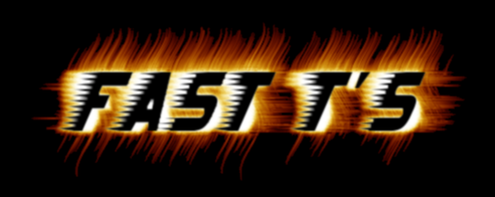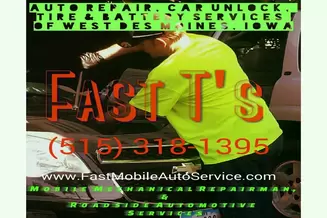Stop!
You have landed at right place to get help with all of your Automotive Problems and car repair!!!
Fast T's Auto Repair Shop on Wheels is your local Leading Mobile Automotive Repair, & Car Service Provider in Waukee & West Des Moines, Iowa 50263/50266. Our Mobile Engine Mechanic Repairmen, allow you the opportunity to invest Your Money in Solving Your Motoring Breakdown Problems On Site, where "Your Parking Spot, Is Our Work Bay!" We Specialize in performance when it comes to what we consider General Automotive Repairs. (the fixes that get you "Back On The Road Again In No Time!")
Our Automotive Unlock - Lockout Service will quickly respond with expedited urgency, to Unlock Your Locked Vehicle, providing you with the Safety, Convienance, & Affordability, You Can Trust!
With always Mobile Tire and Battery Services, Your Flat Tire, or Battery Problems will quickly find an Affordable Alternative, to taking it to a Tire Shop. We will bring Batteries, and Tires to You, and Install them Professionally; Providing Security, Comfort, and Mobility, with world class customer service...alwAYS!!.
Oh No! Better Call
Fast T'sMechanic on Wheels
in
West Des Moines | Waukee
Grimes-Clive-Ankeny-Johnston-Norwalk-Urbandale
Central Iowa<<>>Polk County
We have been called the summa mechanicus or greatest Mechanic!
Save $ and time with On site automotive Repair offering many services allowing you
|
When it comes to Fixing Your Car or Truck Right....
Your
Fast T's Certified
Master Automotive Craftsmen....
Will NOT Compromise on quality!!
Fast T's Expedited Motor Car and Truck Repairmen
"Repairing Your Car Or Truck Fast! For You!"
some of
Fast T's
Motor Car-Repair procedures provided
Central Iowa automotive Mendin by Fast T's of Waukee, IA. 50263 Alternator Replacement and Installation, Starter Replacement and Installation, Ignitions ignition lock cylinders and Ignition switch installation, Outer and inner Tie Rod Replacement and Installation, Control Arms, Ball Joints, Brake Caliper Removal and Installation, Brake pads, Brake Shoes, Wheel Bearing Installation, Wheel bearing and hub assembly removal and replacement, Idler arms, Stabilizer Bars, Sway Bars, Sway Bar Links, Pitman Arms, CV Axles, CV Joints, Shocks, Springs, Coils, Struts, Coil Packs, Spark Plugs, Crankshaft Sensors, Steering Wheels, Steering Wheel Clock Springs, steering wheel angle sensors, Serpentine-Belt Repair, Select Fuel Pumps, Power Steering Pumps and Hoses, Tensioner Pulley Assemblies, Belts, Hoses, Head Lights, Brake Lights, Filters, Harmonic Balancers, Reservoirs, Electric Door and Window Switches, Door Lock Switches, Windshield Wiper Motors, Radio Installation, Car Batteries, Truck Batteries, Passenger Car Tires, Light Truck Tires, Trailer Tires, &Much mORE!!
Our Mechanics or Technician will quickly diagnose your broken down vehicle, recommend, and perform the necessary
Car or Truck Diagnostic & Repairs.
You will be quickly, and efficiently "Back On The Road Again In No Time!"
Discover the Mobile Convenience of having your Motor Fix
provided by
Fast T's Traveling
Engine Mechanics
We Work on and Fix All makes & MODELS of Automobiles
Some of the many makes of vehicles that we work on, fix, and service are: Audi, BMW, Buick, Cadillac, Chevrolet, Chrysler, Dodge, Eagle, Fiat, Ford, Geo, GM, GMC, Honda, Hyundau, Infinity, Kia, Jeep, Lexus, Lincoln, Mazda, Mercedes Benz, Mercury, Mitsubishi, Nissan, Plymouth, Pontiac, Porsche, Saturn, Scion, Smart Car, Sprinter, Suburu, Toyota, Volkswagon,
& More!
& More!
A lil' bout Gas car Engines, and what makes them run
Combustion engines still run on the basic principals of combustion- Air to burn, Fuel to ignite, Spark for ignition, and a contained cylinder for explosion or what is known as combustion. Although gas motors still require these three basic elements of combustion, engine systems, their respective functions, and engine components have changed tremendously over the years. Today you need to have the proper testing equipment, computer scanning tools, ongoing technical training, and hands-on mechanical experience, to fix a car properly. Your Fast T's Car & Truck Mechanical Specialists are well equipped to fix your car or truck.
ALL of our Certified Automotive Repairs ALWAYS include a 24,000 Mile / 3 Year Parts Replacement Warranty & Labor Guarantee for complete Automotive Peace of Mind! For more detailed information about internal combustion engines, please feel free to read the article below from the U.S. Department of Energy at the bottom of this page.
Engine Repairs
3 YEAR/ 24,000 Mile Parts Replacement Warranty & Labor Guarantee On All Certified Automobile Repairs.
BATTERIES, and BATTERY SERVICES
BATTERY TROUBLESHOOTING, Battery Diagnostics - TESTING, Battery INSTALLATION - Replacement
&
Jumpstart - Battery Boost
Passenger Car, & light pickup truck Tire Services
Tire Change, Stripped Lug Nut Removal, Keyed Locknut Removal, & Tire Replacement/Spare Tire Installation.
Gasoline Internal Combustion engines Defined By the U.s. DEPARTMENT of energy
"Internal Combustion Engine Basics"
Article below by U.S. Department of energy
Written:
November 22, 2013 - 2:02pm.
link to Article:
http://energy.gov/eere/energybasics/articles/internal-combustion-engine-basics



"Internal combustion engines provide outstanding drivability and durability, with more than 250 million highway transportation vehicles in the United States relying on them. Along with gasoline or diesel, they can also utilize renewable or alternative fuels (e.g., natural gas, propane, biodiesel, or ethanol). They can also be combined with hybrid electric powertrains to increase fuel economy or plug-in hybrid electric systems to extend the range of plug-in hybrid electric vehicles.
HOW DOES AN INTERNAL COMBUSTION ENGINE WORK?
Combustion, also known as burning, is the basic chemical process of releasing energy from a fuel and air mixture. In an internal combustion engine (ICE), the ignition and combustion of the fuel occurs within the engine itself. The engine then partially converts the energy from the combustion to work. The engine consists of a fixed cylinder and a moving piston. The expanding combustion gases push the piston, which in turn rotates the crankshaft. Ultimately, through a system of gears in the powertrain, this motion drives the vehicle’s wheels.
There are two kinds of internal combustion engines currently in production: the spark ignition gasoline engine and the compression ignition diesel engine. Most of these are four-stroke cycle engines, meaning four piston strokes are needed to complete a cycle. The cycle includes four distinct processes: intake, compression, combustion and power stroke, and exhaust.
Spark ignition gasoline and compression ignition diesel engines differ in how they supply and ignite the fuel. In a spark ignition engine, the fuel is mixed with air and then inducted into the cylinder during the intake process. After the piston compresses the fuel-air mixture, the spark ignites it, causing combustion. The expansion of the combustion gases pushes the piston during the power stroke. In a diesel engine, only air is inducted into the engine and then compressed. Diesel engines then spray the fuel into the hot compressed air at a suitable, measured rate, causing it to ignite.
IMPROVING COMBUSTION ENGINES
Over the last 30 years, research and development has helped manufacturers reduce ICE emissions of criteria pollutants, such as nitrogen oxides (NOx) and particulate matter (PM) by more than 99% to comply with EPA emissions standards. Research has also led to improvements in ICE performance (horsepower and 0-60 mph acceleration time) and efficiency, helping manufacturers maintain or increase fuel economy.
Learn more about our advanced combustion engine research and development efforts focused on making internal combustion engines more energy efficient with minimal emissions."
Article below by U.S. Department of energy
Written:
November 22, 2013 - 2:02pm.
link to Article:
http://energy.gov/eere/energybasics/articles/internal-combustion-engine-basics



"Internal combustion engines provide outstanding drivability and durability, with more than 250 million highway transportation vehicles in the United States relying on them. Along with gasoline or diesel, they can also utilize renewable or alternative fuels (e.g., natural gas, propane, biodiesel, or ethanol). They can also be combined with hybrid electric powertrains to increase fuel economy or plug-in hybrid electric systems to extend the range of plug-in hybrid electric vehicles.
HOW DOES AN INTERNAL COMBUSTION ENGINE WORK?
Combustion, also known as burning, is the basic chemical process of releasing energy from a fuel and air mixture. In an internal combustion engine (ICE), the ignition and combustion of the fuel occurs within the engine itself. The engine then partially converts the energy from the combustion to work. The engine consists of a fixed cylinder and a moving piston. The expanding combustion gases push the piston, which in turn rotates the crankshaft. Ultimately, through a system of gears in the powertrain, this motion drives the vehicle’s wheels.
There are two kinds of internal combustion engines currently in production: the spark ignition gasoline engine and the compression ignition diesel engine. Most of these are four-stroke cycle engines, meaning four piston strokes are needed to complete a cycle. The cycle includes four distinct processes: intake, compression, combustion and power stroke, and exhaust.
Spark ignition gasoline and compression ignition diesel engines differ in how they supply and ignite the fuel. In a spark ignition engine, the fuel is mixed with air and then inducted into the cylinder during the intake process. After the piston compresses the fuel-air mixture, the spark ignites it, causing combustion. The expansion of the combustion gases pushes the piston during the power stroke. In a diesel engine, only air is inducted into the engine and then compressed. Diesel engines then spray the fuel into the hot compressed air at a suitable, measured rate, causing it to ignite.
IMPROVING COMBUSTION ENGINES
Over the last 30 years, research and development has helped manufacturers reduce ICE emissions of criteria pollutants, such as nitrogen oxides (NOx) and particulate matter (PM) by more than 99% to comply with EPA emissions standards. Research has also led to improvements in ICE performance (horsepower and 0-60 mph acceleration time) and efficiency, helping manufacturers maintain or increase fuel economy.
Learn more about our advanced combustion engine research and development efforts focused on making internal combustion engines more energy efficient with minimal emissions."


![image of Fast T's 3 year Auto-Repair Warranty and mechanical labor guarantee in multiple colors. [3 Year-Repair Warranty]](/uploads/7/1/9/2/7192860/published/fast-t-s-car-repair-warranty-and-labor-guarantee.webp?1655774902)